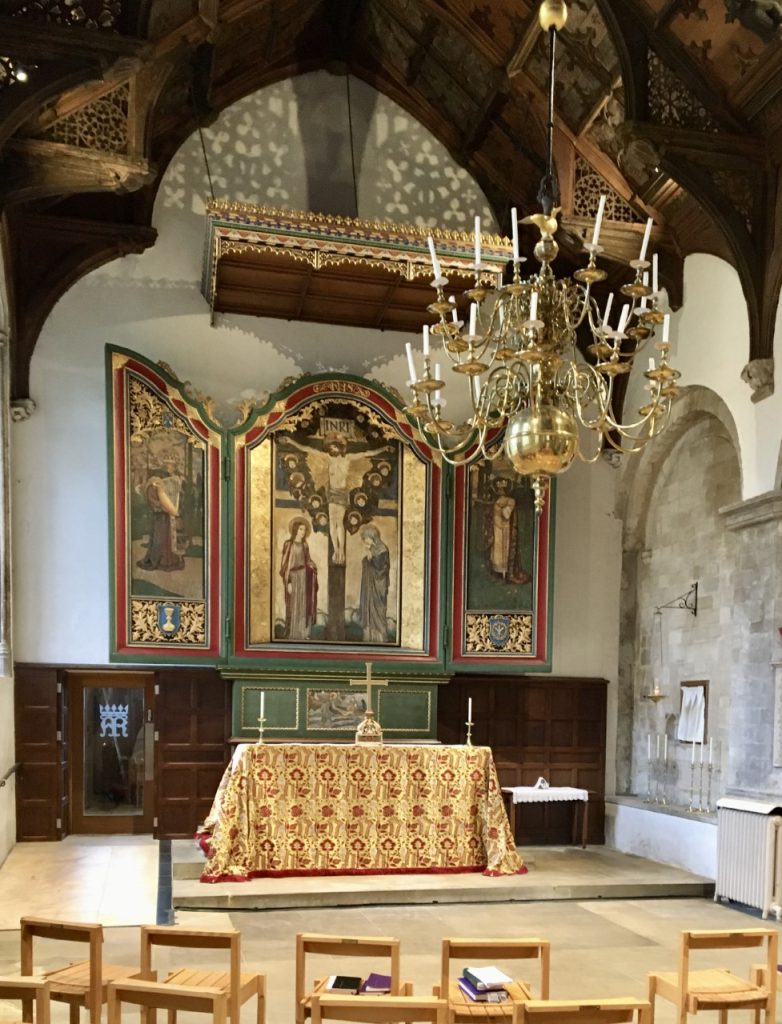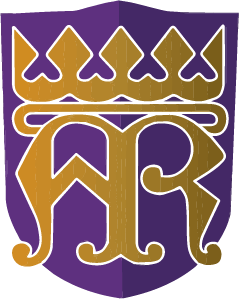Our welcome desk is here on the north aisle of the church. Unusually, there is no entrance on the opposite side. The sunny south side of the church was originally reserved for the monks, whose private cloister and domestic quarters were built there. The north aisle we see today was extended in about 1440 to replace the narrow Norman aisle which had served as a passageway for processions. The present aisle is unusually spacious – wider, in fact, than the central nave. Notice the elaborate hammer-beam roof with its angel figures, ‘grotesques’ such as an ape-like pregnant woman, and stone corbels including a bagpiper, a fox with a goose in its mouth and several fashionably hatted men.
500 years ago, this aisle had small screened-off chapels belonging to the town’s religious gilds. One chapel stood under each window, with a larger Lady Chapel at the far end in honour of Mary, the mother of Jesus. The roof timbers above the altar retain some original paintwork, including an angel with red wings.
The octagonal font is now just inside the entrance. Wymondham people (sometimes adults as well as babies) have been baptised (christened) here for 600 years. It is carved with angels and the symbols of the four gospel-writers, the angel/man (Matthew), lion (Mark), winged ox (Luke) and eagle (John). Our font was a popular mid-15th century design, though sadly defaced by Puritans in 1643. Traces of paint show that, like most church stonework and sculpture, it was originally brightly coloured. The tall font cover by Cecil Upcher was added in the 1950s in East Anglian style and has a hinged doorway that opens out when in use. The statue of Mary opposite the entrance was made in 1947 by the great church architect Sir Ninian Comper who modelled it on his young wife Grace. Comper also designed the tall gilded Paschal candlestick.

A striking feature of this aisle is the large triptych (3-panelled) painting behind the altar. This was installed in 1991 and came from the redundant St Peter’s Church in Lowestoft. The central panel shows the Crucifixion with Saints Mary and John, the outer panels illustrate King David and the East Anglian Saint Edmund. It was made in 1904 by the Arts and Crafts artists E P Warren with plaster reliefs by Robert Anning. The tester (canopy) above was added in 1933 when the chapel was refurnished.
While in the north aisle, don’t miss the elaborate brass chandelier. This was given to the church in 1712 and originally helped light the nave before gas lights were installed in the 1840s. Appropriately for a chapel dedicated to Mary, the figure of Our Lady of Walsingham is a modern addition. Much older is the crowned MR monogram, standing for MARIA or Maria Regina – Mary Queen (of Heaven). This is made of flint set flush into one of the pillars between the aisle and nave.
It is an enigma. It must have been removed from elsewhere and placed here after about 1580. But why are the letters back to front? We now use the monogram as our parish logo. Look also for the Becket Icon, a millennium gift to the Abbey from its maker, Fr David Hunter. Using the traditional style of an Orthodox icon it illustrates events from the life of our patron saint, Thomas Becket, who was murdered in Canterbury Cathedral in 1170.


